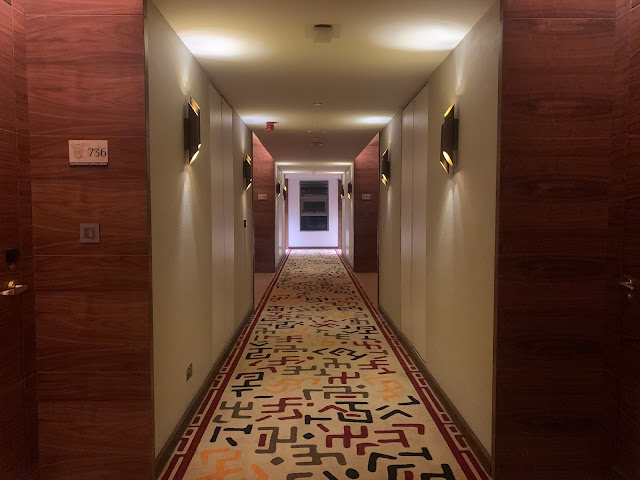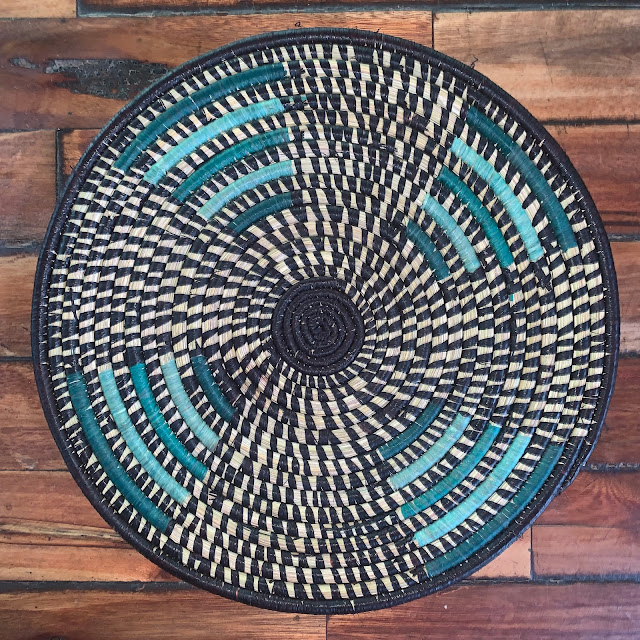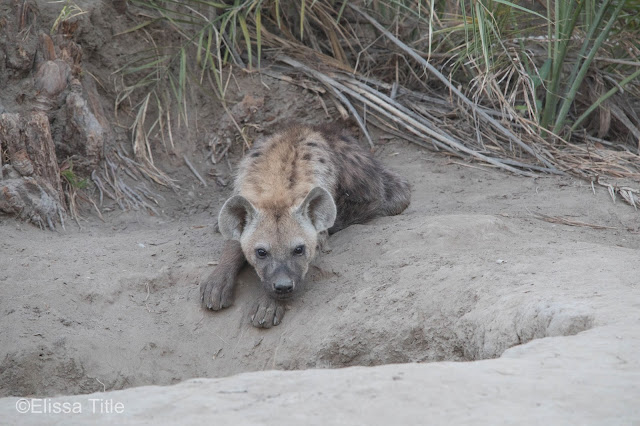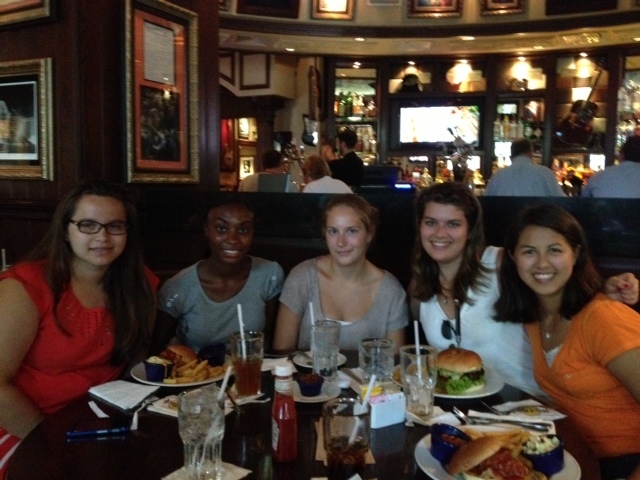Chimping in Kibale
On March 21, we were up before 5:30AM to prepare for chimpanzee trekking (chimping, as it is lovingly called in Tanzania). I had a filling breakfast of a breakfast smoothie, fresh fruit, and poached eggs with avocado toast. It’s a good thing I stuffed my face because we ended up hiking all morning. We left the lodge around 6:40AM for our short 2-minute walk to headquarters. We had the shortest briefing ever (the ranger literally just gave us a few generic rules like wearing your mask, keeping appropriate distance from the chimpanzees, and not eating/drinking near them) before meeting our lead ranger, Sarah. We walked from headquarters down the dirt path, turning left onto the main paved road. We walked along the road for maybe 5-10 minutes before crossing it and heading off into the forest. As we walked through the forest, I noticed how different the landscape is here than in Bwindi. Unlike Bwindi’s mountainous, rocky, impenetrable terrain, the main trail for our hike was covered by soggy leaves, the occasional mushrooms, and forest elephant poop. When we veered off the main path, however, the terrain quickly became an adventure trying to navigate around, between, and through thorny trees. We came across our first unhabituated wild chimpanzee around one hour into the hike.
He was high up in the tree, and thus difficult to photograph, but visible enough to enjoy his presence. We kept circling around the same tree like eager vultures attempting (and mostly failing) to get a better angle. Sarah was hoping he’d call out to the rest of the group, guiding the rest of the family towards the tree he was eating from.
When that didn’t happen, we set off on the main trail once more to find other chimpanzees. At one point, we crossed several wooden walkways overgrown with leaves, a scene that looked like it could have been out of Jurassic Park. I found the wooden walkways to be more of a nuisance than a help. In several areas, the wood was either rotting and creating a giant hole that you often couldn’t see due to the forest’s growth or the spacing between wooden beams was so uneven that you had to carefully place your feet as to not get your foot caught in between.
Eventually, we came across more chimpanzees of the same family. That was quite the experience… They were on the move, which meant we followed them. Obviously, they’re wild, which meant we were not walking along the main path. In fact, we weren’t walking at all. We were crashing through the bush, stepping over fallen trees, getting caught in vines on the forest floor, getting caught on thorny trees. Trees smacked us in the face as we followed the chimps, all while they were hooting and pounding on hollowed trees. Every time we caught up to them, they’d be on the move again and I’d be debating whether to look at the ground to watch my footing or look straight ahead to make sure I wasn’t about to run into a tree. I decided my footing was more important so while I stared at the ground as we sped through the forest, I was also ducking and swatting away branches with the back of my hands to somewhat protect my face. The chimps did sit still for a few minutes, but for the most part they were flying through the forest, unaffected by the obstacle course the forest presented (at times it felt like I was doing hurdles over fallen trees).
 |
| One of the overgrown pathways in Kibale. |
Uganda has nearly 5,000 chimpanzees and out of these, around 1,500 are found in Kibale National Park. However, Kibale National Park in the Kabarole district is the only place where chimpanzee habituation is done in Uganda. With unhabituated chimps, you are allowed 4 hours with them since it’s part of the process to getting them used to being around humans. With the habituated groups, you’re allowed one hour from time of sighting like with the gorillas. Because the unhabituated chimps aren’t yet used to human presence, they generally tend to be high up in the trees. When the chimps weren’t doing much, we all sat down on the forest floor and ate our packed lunch, sipping juice boxes and eating our packed sandwiches like we were in kindergarten again. Soon after, the chimps were on the move again, so we resumed tracking them. I ended up putting my camera away because I didn't want to run through the forest trying to keep myself upright while balancing the camera. After awhile, it makes me lopsided!!
 |
| When you're around the chimps, you need to wear a mask to protect them. |
 |
| One of the wooden pathways-- this one was in better shape than most. |
The trek was wild, to say the least. An 8-mile hike (about 7 hours in duration) tracking unhabituated chimps through the forest is an experience I have no desire to repeat again. I don’t know how chimps can move so gracefully through the foliage—I kept tripping, but I stayed on my feet! Other than a few scratches, bumps that filled with pus (I'm thinking it was a reaction to a plant), a stick that poked me in my eye, spiders in my hair, and a golf ball size bruise on my left arm, I made it in one piece, so I consider that a success.
Comparative to Mahale, where I trekked chimpanzees in 2014, Uganda feels more primitive and wilder. I would have preferred to have two days to trek habituated chimps which would have been an even more thrilling experience at least to me (an unpopular opinion though, everyone else loved it). With the unhabituated chimps, I felt like I was constantly trying to catch up, never really getting more than a glimpse of them let alone a picture. With the gorillas, both of our trekking days were so different photographically that I would have preferred two photographic opportunities for the chimps. Even though I didn't do the second hike, I found I preferred my chimpanzee experience in Tanzania’s Gombe Stream where I was able to observe them in the open and enjoy their presence much more. At the end of our trek and similar to with the gorillas, we received a chimpanzee tracking certificate to commemorate our experience.
On March 22, I woke up to a thunderstorm. I had tweaked my back the day before while aiming my 150-600mm lens high up to photograph the chimps in the tree, so I decided to skip the chimpanzee trek in the morning. I think that was a wise decision because as the group left for the trek, the rain picked up and it started raining heavily. Maximizing photographic opportunities is great, but sometimes you need to just listen to your body, slow down, and take a loss. I sat in the main part of the lodge writing this blog, editing photos, watching the rain pour down in front of me, and drinking lots of Ugandan tea! It might not be everyone's definition of perfect but in that moment, it was mine.
I patiently waited for the group to return and when 3PM hit and they still weren't back, I had lunch: more fish and chips. The fish in Africa is always so fresh and delicious. This fish came from the Nile and was some of the best fish and chips I've ever had.
While the group was gone, I worked some magic... When we first arrived at the lodge, I noticed gorgeous handwoven placemats that, in all my trips to Africa, were unlike anything I had seen before. A day prior, when I had asked the lodge manager if I could buy them somewhere, I was told that these come from one very specific region in Uganda near the border with Rwanda and the placemats were unlike anything he's even ever seen. He told me that if he could get some replacements for the lodge, he'd sell some to me. So, he called up the artist who makes them. Fast forward to the habituated chimpanzee trek-- As I was sitting sipping my tea, the lodge manager approached me and said he'd be able to get replacements... So I bought 5 from him! Of course I made sure I wasn't inconveniencing him (I wasn't). He seemed so happy that I appreciated the fine details so much, and this is just one of the many examples of the wonderful hospitality you continually receive in Africa.
Even though I was dying to go back to the community to photograph again, the hike left me exhausted and sore, so I spent the rest of the afternoon editing photos, catching up on blog entries, and repacking (ensuring all my baskets were well padded for our upcoming travel day!!)
 |
| All the baskets I bought while in Uganda. |
The following morning was a jam-packed travel day. I was up at 5am, we had breakfast at 6am, we left the lodge at 6:30am, had a 90 minute drive to the airport and then waited over an hour for the plane to arrive.
When we boarded, the pilot said the weather was "ish ish" and someone asked, "well if you landed in it once, you can do it again right?" to which the co-pilot was silent... Reassuring, right? It also looked like the pilot was undergoing training-- he was taking photographs of the plane when we first boarded and then the co-pilot seemed to be instructing him. We flew just over an hour to a town near Entebbe. The flight was smooth, other than when I almost had a heart attack as we were landing! The drastically slowed down on the runway approach and it felt like the entire plane was about to nose dive. You could feel the difference in gravity as we slowed, and I was very glad when we touched down. In all my trips to Africa, I never had something like that happen... Whew! We then had a 40 minute drive to Karibu Entebbe where we had lunch before transferring to Entebbe International Airport where we arrived at least 2 hours before our one hour flight to Nairobi. When we landed in Kenya, we went through health checks and collected our bags, many of which had x's chalked onto the sides. Apparently, that means you had electronics in your checked bag but I know for a fact that I did not, so I don't know how accurate that is! We sat in some rush hour traffic on the way to the hotel (a beautiful 5 star hotel that we got upgraded to due to a booking error).
 |
| Many hotels and the airport have metal sculptures of wildlife. |
 |
| Lobby of the hotel looking towards the entrance. |
 |
| I loved the carpet in the hallway! |
 |
| Our room at Ole Sereni. |
 |
| Sculptures by the dining room of Ole Sereni. |
After checking in, we had dinner (I had a great Indian ocean snapper with katsu sauce and picked red onion and ginger with a Tusker beer to go with it).
By the time we were done with dinner, it was almost 9pm. That's a 5am-9pm day and boy, was I exhausted! As always, wifi in Africa can be spotty but I'll be keeping a detailed account of my experiences in Uganda and Kenya and uploading blogs with photos when I can! Stay tuned for more, and follow along with my Instagram @elissatitle for more pics.






















Comments
Post a Comment